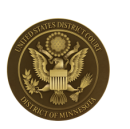Policy on Use of Electronic Devices in U.S. Courthouses in the District of Minnesota
(Effective January 1, 2024)
Members of the public, media representatives, and attorneys may bring electronic devices (including smart phones, tablets, and laptops) into any U.S. Courthouse in the District of Minnesota subject to the following restrictions:
- Subject to administrative inspection. Any electronic device brought into a U.S. Courthouse may be inspected by a Deputy U.S. Marshal, Court Security Officer, Federal Protective Service or Protective Security Officer.
- In general, no photography, recording, broadcasting, or transmission is allowed.
- Court Proceedings. Unless specifically authorized by the Chief Judge or by a judge presiding over a ceremonial court proceeding, no person may use an electronic device to photograph or record any court proceeding, courtroom, court office, or court staff member, or to broadcast or otherwise transmit any part of any court proceeding.
- Building common areas. No person may use an electronic device to photograph or record the following areas of the courthouse: All building entrances and exits, security checkpoint, General Service Administration common areas, public spaces, lobbies, foyers, corridors, and auditoriums. Prior written approval for photography or recording in these areas must be obtain by the Chief Judge.
- Limited exception for using cameras or electronic recording devices. Members of the credentialed media may use cameras or other electronic recording devices in courthouse lobbies and, with the permission of the U.S. Attorney, in the U.S. Attorney’s Office space. The U.S. Marshal may limit the ability to use these devices within the courthouse lobbies by controlling where and when the media may use such devices in order to protect the ability of the public to ingress and egress the building and for other purposes related to court security.
Court personnel and court contracted vendors may record ceremonial events in the courtroom and courthouse as approved by the Public Information Officer or Clerk of Court.
- Use in courtrooms. Any electronic device that is brought into a courtroom by the general public or attorney must be powered off and stored away; an electronic device must not be held in any person’s hand. The presiding judge may authorize an exception to this rule for an attorney who has appeared in the matter. Credentialed media members should consult the Court’s Media Plan for additional guidance on permitted use of electronic devices in a courtroom.
- Storing cameras and electronic recording devices in news media rooms. Members of the media who have applied for and obtained permission to use the news media rooms in the Minneapolis and St. Paul courthouse may store their cameras or other electronic recording devices, other than a cell phone, in the news media rooms, but such equipment must be rendered inoperable while it is outside of the areas designated in paragraph 2.c.
- Ad hoc pouching of devices. On days deemed necessary by a judge, all visitors to the courthouse (even those who do not plan to attend the hearing or trial that triggered the enhanced security measures) will be required to place their personal electronic devices into locked pouches for the duration of their visit. Visitors will be able to unlock the pouches as they leave the courthouse. There are exemptions allowing specific individuals to keep their personal electronic devices without placing them in locked pouches, including:
- court staff (including volunteers and externs);
- attorneys who are members of the District’s bar;
- attorneys who have made an appearance in a case being heard in that courthouse on that day;
- credentialed media;
- summoned and seated jurors;
- law-enforcement officers on official business;
- federal/GSA contractors;
- persons with biometric sensors; and
- students or invitees of pre-arranged training or activities.
To be exempted from placing personal electronic devices in a locked pouch, members of the media must carry and display their court-issued media badge when arriving at security screening. Members of the media unable to display their credentials will be treated the same as members of the general public and required to place all personal electronic devices in a locked pouch for the duration of their visit. The bench has implemented this policy in order to improve our courthouse security and protect the safety of judges, jurors, witnesses, victims, and other individuals involved in high-profile or sensitive proceedings.
- Violations of this Policy. Any person who violates this Policy must be removed from a courtroom or courthouse by a Deputy U.S. Marshal, Court Security Officer, Federal Protective Service or Protective Security Officer. In addition, a Deputy U.S. Marshal or Court Security Officer may confiscate any electronic device from any person who violates paragraph 3 of this policy, provided that the Deputy U.S. Marshal or Court Security Officer immediately presents the device and the alleged violator to the presiding judge or Chief Judge.
- High-Risk Proceedings. The presiding judge must confer with the U.S. Marshals Service in advance of any trial or other proceeding that involves heightened security concerns about whether additional precautions should be taken with respect to electronic devices.
